Abstract
BACKGROUND: The value of measuring airway responsiveness in asthma research is currently limited by the number of different methods used by different investigators, by the lack of a standardised method of expressing precision, and by an inability to equate the results of one method with those of another. METHODS: Two pairs of measurements of airway responsiveness to methacholine were performed in 20 asthmatic subjects, one pair using a dosimeter method (AR-D) and one pair using the conventional Wright nebuliser tidal breathing method (AR-W). The two methods normally use different techniques for quantifying changing levels in forced expiratory volume in one second (FEV1) after each dose of methacholine (the mean of the highest three of six measurements for AR-D, the lower of two measurements for AR-W), and different techniques for expressing measurements of airway responsiveness (the provoking dose (PD20) and the provoking concentration (PC20) respectively responsible for a 20% decrement in FEV1). RESULTS: The coefficient of repeatability (and hence precision) for the measurement of airway responsiveness was significantly better for AR-D (3.0) than for AR-W (10.9), but the technique for quantifying FEV1 contributed more to this than the technique for delivering methacholine. A PC20 of 1 mg/ml with AR-W was equivalent to a PD20 of 103 micrograms with AR-D. CONCLUSIONS: It is practical as well as desirable to compare the precision of different techniques for the measurement of airway responsiveness and to derive conversion factors so that results may be equated.
Full text
PDF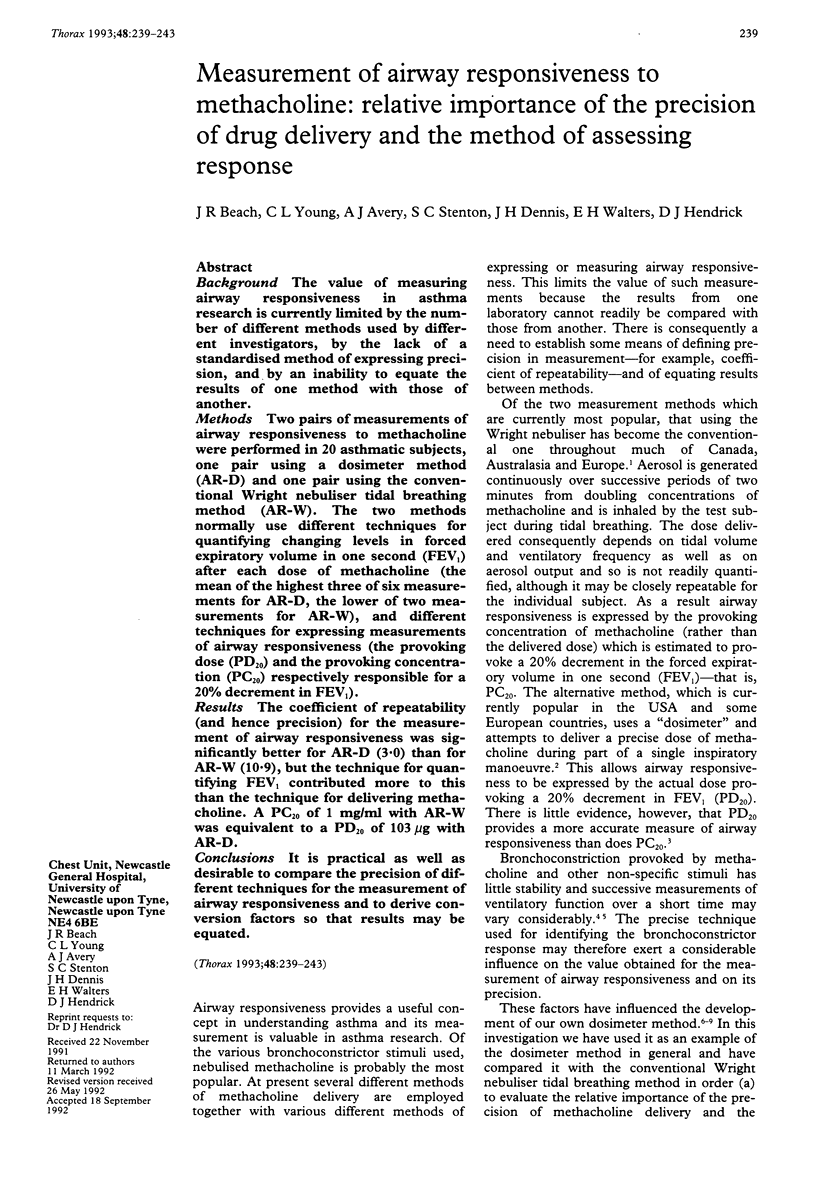
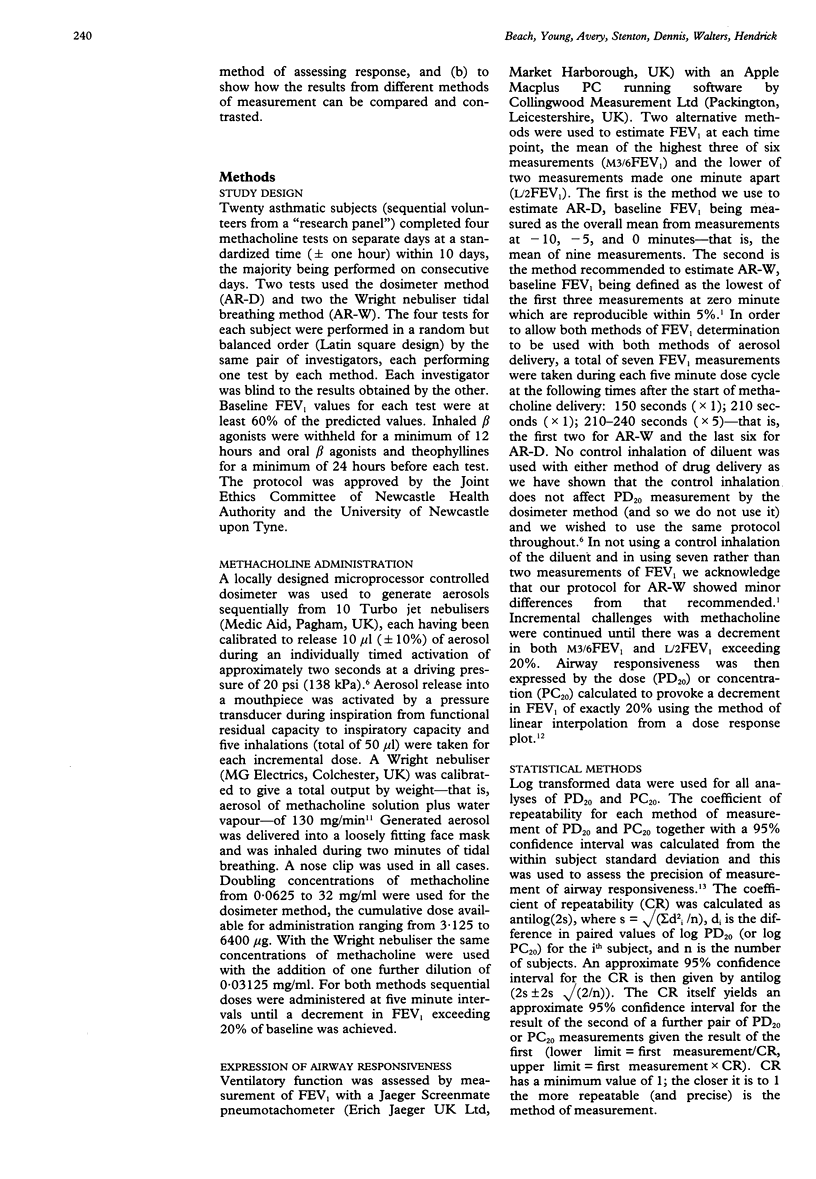
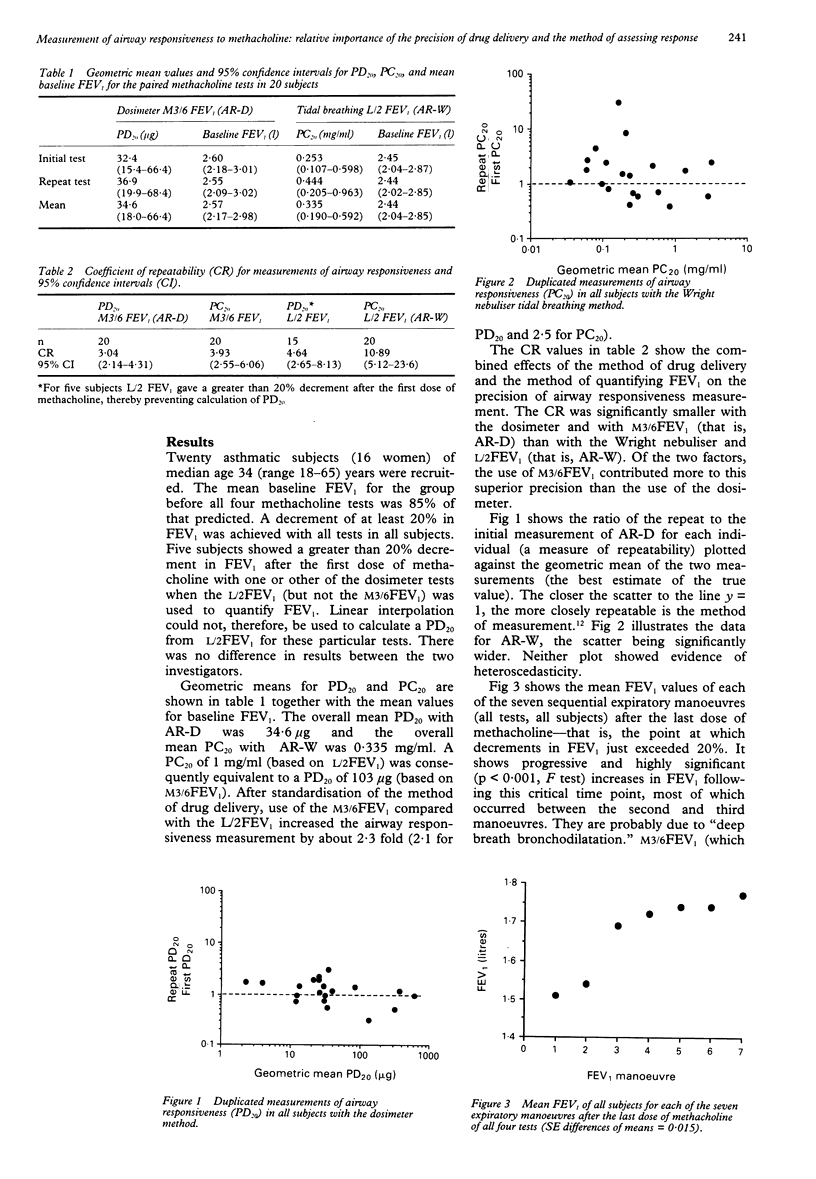
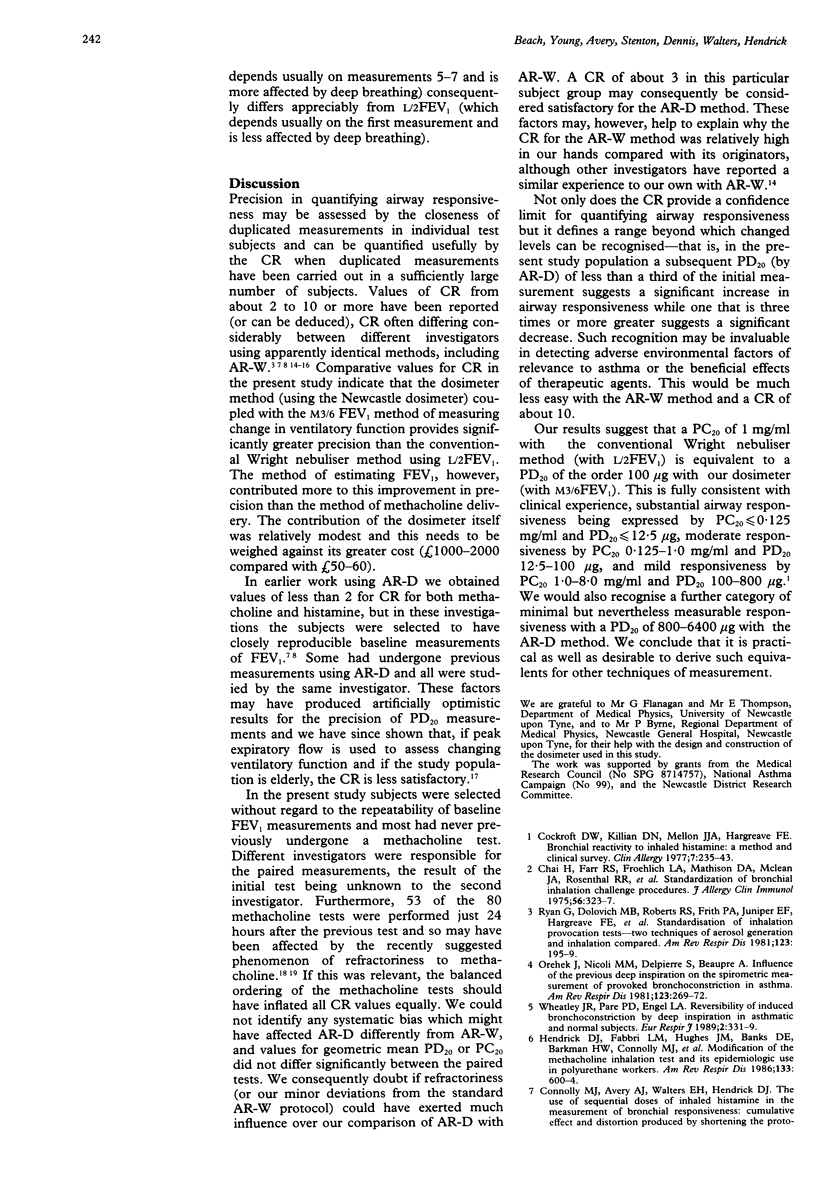
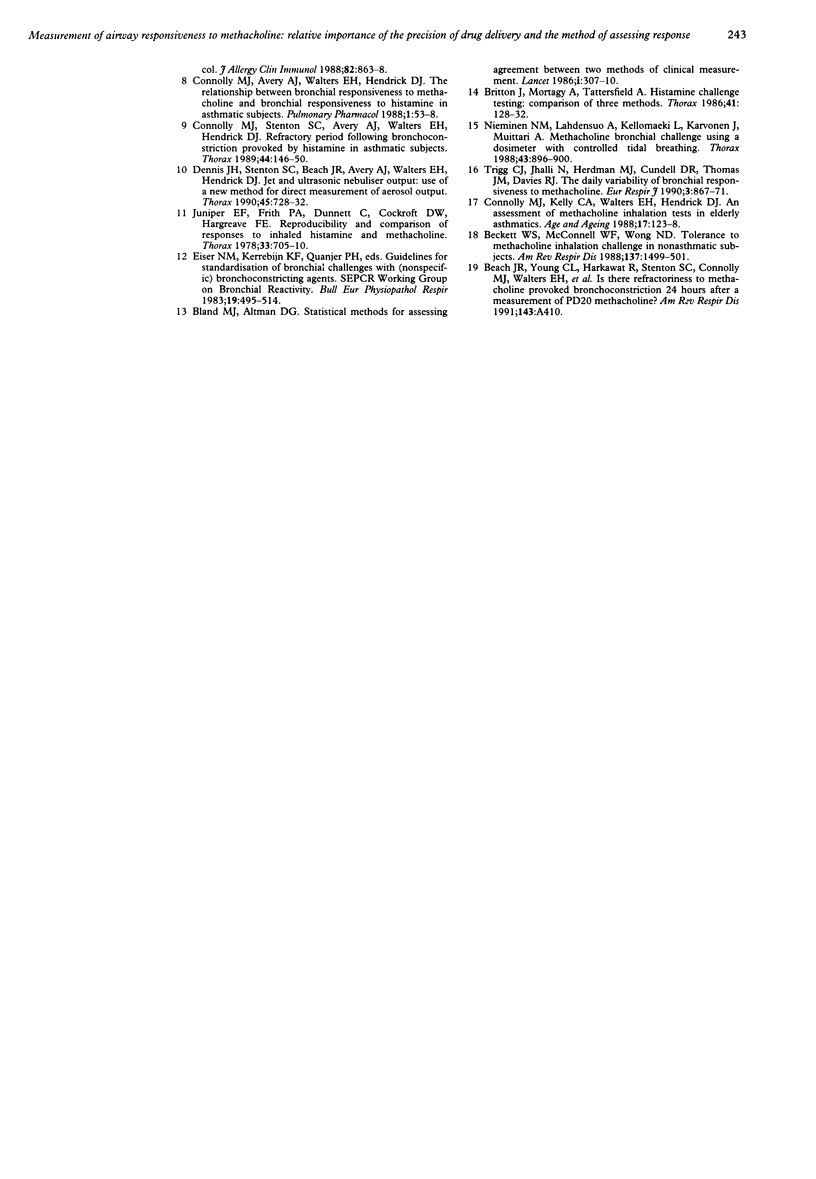
Selected References
These references are in PubMed. This may not be the complete list of references from this article.
- Beckett W. S., McDonnell W. F., 3rd, Wong N. D. Tolerance to methacholine inhalation challenge in nonasthmatic subjects. Am Rev Respir Dis. 1988 Jun;137(6):1499–1501. doi: 10.1164/ajrccm/137.6.1499. [DOI] [PubMed] [Google Scholar]
- Bland J. M., Altman D. G. Statistical methods for assessing agreement between two methods of clinical measurement. Lancet. 1986 Feb 8;1(8476):307–310. [PubMed] [Google Scholar]
- Britton J., Mortagy A., Tattersfield A. Histamine challenge testing: comparison of three methods. Thorax. 1986 Feb;41(2):128–132. doi: 10.1136/thx.41.2.128. [DOI] [PMC free article] [PubMed] [Google Scholar]
- Chai H., Farr R. S., Froehlich L. A., Mathison D. A., McLean J. A., Rosenthal R. R., Sheffer A. L., Spector S. L., Townley R. G. Standardization of bronchial inhalation challenge procedures. J Allergy Clin Immunol. 1975 Oct;56(4):323–327. doi: 10.1016/0091-6749(75)90107-4. [DOI] [PubMed] [Google Scholar]
- Cockcroft D. W., Killian D. N., Mellon J. J., Hargreave F. E. Bronchial reactivity to inhaled histamine: a method and clinical survey. Clin Allergy. 1977 May;7(3):235–243. doi: 10.1111/j.1365-2222.1977.tb01448.x. [DOI] [PubMed] [Google Scholar]
- Connolly M. J., Avery A. J., Walters E. H., Hendrick D. J. The relationship between bronchial responsiveness to methacholine and bronchial responsiveness to histamine in asthmatic subjects. Pulm Pharmacol. 1988;1(1):53–58. doi: 10.1016/0952-0600(88)90011-7. [DOI] [PubMed] [Google Scholar]
- Connolly M. J., Kelly C., Walters E. H., Hendrick D. J. An assessment of methacholine inhalation tests in elderly asthmatics. Age Ageing. 1988 Mar;17(2):123–128. doi: 10.1093/ageing/17.2.123. [DOI] [PubMed] [Google Scholar]
- Connolly M. J., Stenton S. C., Avery A. J., Walters E. H., Hendrick D. J. Refractory period following bronchoconstriction provoked by histamine in asthmatic subjects. Thorax. 1989 Feb;44(2):146–150. doi: 10.1136/thx.44.2.146. [DOI] [PMC free article] [PubMed] [Google Scholar]
- Dennis J. H., Stenton S. C., Beach J. R., Avery A. J., Walters E. H., Hendrick D. J. Jet and ultrasonic nebuliser output: use of a new method for direct measurement of aerosol output. Thorax. 1990 Oct;45(10):728–732. doi: 10.1136/thx.45.10.728. [DOI] [PMC free article] [PubMed] [Google Scholar]
- Hendrick D. J., Fabbri L. M., Hughes J. M., Banks D. E., Barkman H. W., Jr, Connolly M. J., Jones R. N., Weill H. Modification of the methacholine inhalation test and its epidemiologic use in polyurethane workers. Am Rev Respir Dis. 1986 Apr;133(4):600–604. doi: 10.1164/arrd.1986.133.4.600. [DOI] [PubMed] [Google Scholar]
- Juniper E. F., Frith P. A., Dunnett C., Cockcroft D. W., Hargreave F. E. Reproducibility and comparison of responses to inhaled histamine and methacholine. Thorax. 1978 Dec;33(6):705–710. doi: 10.1136/thx.33.6.705. [DOI] [PMC free article] [PubMed] [Google Scholar]
- Nieminen M. M., Lahdensuo A., Kellomaeki L., Karvonen J., Muittari A. Methacholine bronchial challenge using a dosimeter with controlled tidal breathing. Thorax. 1988 Nov;43(11):896–900. doi: 10.1136/thx.43.11.896. [DOI] [PMC free article] [PubMed] [Google Scholar]
- Orehek J., Nicoli M. M., Delpierre S., Beaupre A. Influence of the previous deep inspiration on the spirometric measurement of provoked bronchoconstriction in asthma. Am Rev Respir Dis. 1981 Mar;123(3):269–272. doi: 10.1164/arrd.1981.123.3.269. [DOI] [PubMed] [Google Scholar]
- Ryan G., Dolovich M. B., Roberts R. S., Frith P. A., Juniper E. F., Hargreave F. E., Newhouse M. T. Standardization of inhalation provocation tests: two techniques of aerosol generation and inhalation compared. Am Rev Respir Dis. 1981 Feb;123(2):195–199. doi: 10.1164/arrd.1981.123.2.195. [DOI] [PubMed] [Google Scholar]
- Wheatley J. R., Paré P. D., Engel L. A. Reversibility of induced bronchoconstriction by deep inspiration in asthmatic and normal subjects. Eur Respir J. 1989 Apr;2(4):331–339. [PubMed] [Google Scholar]


